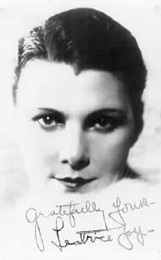
Josephine Baker in La Revue des Revues 1927
Between 1918 and 1922 the only women who bobbed their hair were those who had been on active service. About 1922 milliners began to take a hand in the proceedings. They invented a hat known as the "cloche." Ladies found when purchasing their hats that there was new war on - hats versus hair! They repaired to their unfortunate hairdresser and told him that he was a rotten hairdresser, that he was stupid, and, owing to him, they couldn't find a hat to suit them. Wise in his generation, the hairdresser "thinned" out the hair until the back adornment was but a small chignon, which could easily be tucked into a hat. Again came the milliners, who evolved a fashion which would not accommodate even this tiny "bun."

Marion Davies
If the milliners had their way they would have done away with hair. But, hair being the hairdresser's living, he cut ladies' hair "a la victime." Again came the milliners, and the shingle resulted. The Eton crop, which had not really supervened, was "lovely." "Why, it makes women look nearly as pretty as men!" Why are women looking for a new fashion? Because there are so many ill-trained and inferior workmen. Workmen who leave a lady's hair in such a condition that a self-respecting rat would refuse to gnaw it. The result is bound to be that women will look for some mode of hairdressing not so conspicuous. This will probably be a reversion to a style similar to that brought about by the imitators of La Martin - there will be an intermediate fashion of hair a trifle longer than the shingle, which, will give the hairdresser (the real hairdresser) a chance to manipulate his tools, and produce a better result.

Leatrice Joy
Hairdressing is a sound proposition as long as the essential rules are observed. It is no good cutting the hair of a giraffe-necked lady in the same manner as a short-necked one. Nothing looks worse in the London theatres than the fearful array of bare necks, especially those that have been shaved some time previously and now bear traces of the new growth. The bad artist has bigger chances with long hair. The short-hair man who can soften down those "bumps" which the phrenologist loves and the hairdresser hates is the successful man in the hairdressing profession. Newspapers have been announcing great changes in Court hairdressing. That is a mere matter of logic. Take the average shingled lady. Where could the Court hairdresser affix the necessary feathers, diamond tiaras, veils, etc.? If there is no hair there is no foundation. What does a long-necked, shingled woman, with two or three yards of train, look like? Women have, through the ages, sacrificed their hair to some deity or other. At the present day it is to the goddess Fashion. But be hair worn long or short, bobbed or shingled, there is, and will always be, plenty of work for the man or woman whose mission in life it is to make women more charming (if possible) than he has found her.